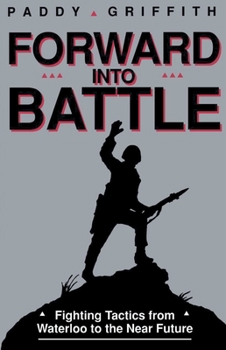Forward Into Battle: Fighting Tactics from Waterloo to the Near Future
Select Format
Select Condition 
Book Overview
For the first time in softcover, this is the greatly expanded second edition of Paddy Griffith's challenging work on battlefield tactics. The first edition (1981) took a critical look at the accepted... This description may be from another edition of this product.
Format:Paperback
Language:English
ISBN:0891414711
ISBN13:9780891414711
Release Date:January 1991
Publisher:Random House Publishing Group
Length:240 Pages
Weight:0.75 lbs.
Dimensions:0.7" x 5.9" x 9.1"
Related Subjects
Engineering History Military Modern (16th-21st Centuries) Napoleonic Wars Strategy TechnologyCustomer Reviews
3 ratings
Importance of Shock Action
Published by Thriftbooks.com User , 18 years ago
Paddy Griffith argues that the importance of firepower has been overestimated relative to shock action. For instance, Griffith contends that Wellington's army was successful not simply because of its volley fire but more importantly from the subsequent charge. He argues that at New Orleans poor troops lacking discipline failed to take a fortified line that good troops could have taken. He details the rise of light infantry through the 1800s. Then he shows that the shock action of brief artillery bombardments and stormtrooper tactics broke through the trenches of World War I. With every technological advance and increase in firepower, people have prophesied an "empty battlefield" and neglected shock at their peril.
Required Reading for USMC Majors
Published by Thriftbooks.com User , 18 years ago
Paddy Griffith spent a decade and a half lecturing officer cadets at Sandhurst on tactics, and this book shows why. After a brief introduction, an outdated narrative with the USSR attacking NATO, the book settles into four case studies. The first study is that of firepower vs shock in the period 1808-1815, the Napoleonic wars, including the War of 1812. Griffith shows that earlier theories about the British lining up and pouring massed musketry into the French were wrong. Instead the British would use fire to disrupt the French long enough for a charge to be delivered. As an addition, Griffith studies a failure of the British system at New Orleans, showing that the rifle made effectively no contribution on the American side beyond sniping a single Colonel. The second study covers the period 1815-1915 and asks whether the empty battlefield was a new phenmemon. In particular there are studies of whether the rifle caused a revolution in warfare during the American Civil War (later expanded into his book "Battle Tactics of the Civil War") and the French Army in 1914. The third covers the relationship between Armour and Infantry, making a forceful argument that Armour did not replace Infantry. Parts of this chapter were later expanded into "Battle Tactics of the Western Front". The fourth covers the Vietnam War and make another forceful argument that the Vietnamese simply outfought the allies on the ground, and achieved their objectives much more frequently than the allies. It is generally scathing of the US reliance on technology, and points out that the North Vietnamese were generally the tactical initiators and held the initiative. It also makes a forceful argument that what the allies needed was more tanks and heavy weapons to support the infantry instead of inaccurate artillery and airpower. The final chapter deals with various changes in war since Vietnam. In general the book is easy to follow, and it's arguments persuesive, and fully referenced. It is a book about the tactics adopted by a few scared men under fire rather and how the nature of war at a personal level has changed rather than a book on grand strategy. If the Commandant General requires all his Majors to read this book who am I to argue?
A brilliant discussion of the tactical fundimentals of war.
Published by Thriftbooks.com User , 24 years ago
Over the years Griffith has established himself as a contraversial and insightful military theorist. His insight into the fundimental tactical principles of warfare, and thier application and mis-application under differing combat venues is an interesting read. He continues his discussion from his other books on the merits of shock verses skirmish tactics, and the effectiveness of stand-off assault verses direct engagement. While his opinions may be viewed as somewhat eurocentric, much of the history of the western method of war is europian based, and this historical perspective is necessary in order to understand the invariate human reaction to combat tactics. His findings in this book are less contraversial than those of "Civil War Battle Tactics", but both books display brilliant insight and are well worth reading.




